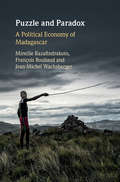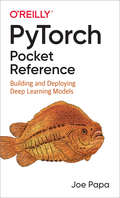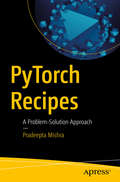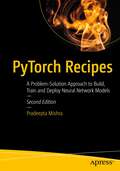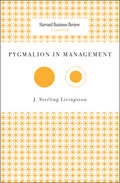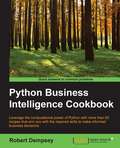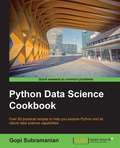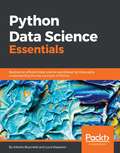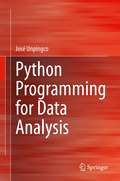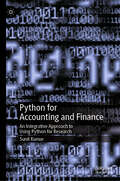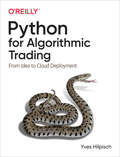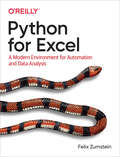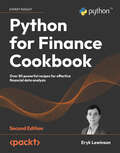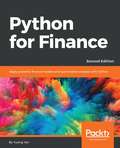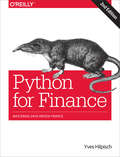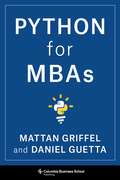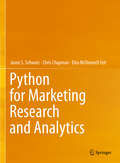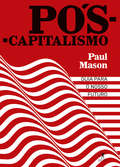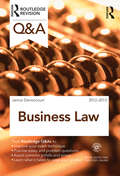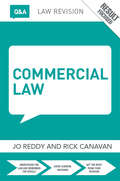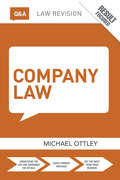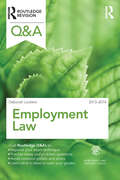- Table View
- List View
Puzzle and Paradox: A Political Economy of Madagascar
by Mireille Razafindrakoto François Roubaud Jean-Michel WachsbergerMadagascar's long-term trajectory is unique: not only has GDP per capita been trending downward since 1960 (the puzzle), but every time the country has set out on path of growth, it has been stopped in its tracks by a socio-political crisis that has shattered the hopes it raised (the paradox). No satisfactory explanation of this failure has been provided so far. This book elaborates a model of intelligibility of Madagascar's downfall, based on an integrated political economy approach as well as mobilizing the most recent development theories. Combining a review of historical literature with original and sometimes unique statistical surveys, it proposes a general interpretative framework for the workings of Malagasy society. Richly documented and accessible, Puzzle and Paradox allows readers to understand Madagascar's sociopolitical history while more broadly offering an opportunity to grasp the different dimensions of development in the Global South.
Puzzles, Paradoxes, Controversies, and the Global Economy
by Charles Wolf Jr.In this wide-ranging collection of essays first published between 2007 and 2014, Charles Wolf Jr. shares his insights on the world's economies, including those of China, the United States, Japan, Korea, India, and others. First appearing in such periodicals as in Forbes, the Wall Street Journal, and the Weekly Standard, among others, these chapters take on a range of questions about the global economy. Wolf discusses the paradoxes and puzzles within China's political economy and in its interactions with the United States. He analyzes the shortcomings of Keynesian economics as a response to the 2008 recession, as well as the weaknesses of policies and actions inferred from the theory, and compares those weaknesses with those of austerity policies intended to limit government spending and indebtedness. He also offers his views on economic inequality and where its principal sources may truly lay, China's currency and the continuing controversy about whether and when it may become a major international reserve currency, and many more insights on key economic issues affecting the global economy. Bringing these essays together for the first time in a single volume, including two essays not yet published elsewhere, this book enables the reader to absorb the author's expert perspective during the years in a collection in which the whole is truly greater than the sum of its parts. Each chapter includes a brief "postaudit" in which the author attempts to grade how well or ill the essay seems in retrospect.
PyTorch Pocket Reference
by Joe PapaThis concise, easy-to-use reference puts one of the most popular frameworks for deep learning research and development at your fingertips. Author Joe Papa provides instant access to syntax, design patterns, and code examples to accelerate your development and reduce the time you spend searching for answers.Research scientists, machine learning engineers, and software developers will find clear, structured PyTorch code that covers every step of neural network development-from loading data to customizing training loops to model optimization and GPU/TPU acceleration. Quickly learn how to deploy your code to production using AWS, Google Cloud, or Azure and deploy your ML models to mobile and edge devices.Learn basic PyTorch syntax and design patternsCreate custom models and data transformsTrain and deploy models using a GPU and TPUTrain and test a deep learning classifierAccelerate training using optimization and distributed trainingAccess useful PyTorch libraries and the PyTorch ecosystem
PyTorch Recipes: A Problem-Solution Approach
by Pradeepta MishraGet up to speed with the deep learning concepts of Pytorch using a problem-solution approach. Starting with an introduction to PyTorch, you'll get familiarized with tensors, a type of data structure used to calculate arithmetic operations and also learn how they operate. You will then take a look at probability distributions using PyTorch and get acquainted with its concepts. Further you will dive into transformations and graph computations with PyTorch. Along the way you will take a look at common issues faced with neural network implementation and tensor differentiation, and get the best solutions for them. Moving on to algorithms; you will learn how PyTorch works with supervised and unsupervised algorithms. You will see how convolutional neural networks, deep neural networks, and recurrent neural networks work using PyTorch. In conclusion you will get acquainted with natural language processing and text processing using PyTorch.What You Will LearnMaster tensor operations for dynamic graph-based calculations using PyTorchCreate PyTorch transformations and graph computations for neural networksCarry out supervised and unsupervised learning using PyTorch Work with deep learning algorithms such as CNN and RNNBuild LSTM models in PyTorch Use PyTorch for text processing Who This Book Is ForReaders wanting to dive straight into programming PyTorch.
PyTorch Recipes: A Problem-Solution Approach to Build, Train and Deploy Neural Network Models
by Pradeepta MishraLearn how to use PyTorch to build neural network models using code snippets updated for this second edition. This book includes new chapters covering topics such as distributed PyTorch modeling, deploying PyTorch models in production, and developments around PyTorch with updated code.You'll start by learning how to use tensors to develop and fine-tune neural network models and implement deep learning models such as LSTMs, and RNNs. Next, you'll explore probability distribution concepts using PyTorch, as well as supervised and unsupervised algorithms with PyTorch. This is followed by a deep dive on building models with convolutional neural networks, deep neural networks, and recurrent neural networks using PyTorch. This new edition covers also topics such as Scorch, a compatible module equivalent to the Scikit machine learning library, model quantization to reduce parameter size, and preparing a model for deployment within a production system. Distributed parallel processing for balancing PyTorch workloads, using PyTorch for image processing, audio analysis, and model interpretation are also covered in detail. Each chapter includes recipe code snippets to perform specific activities.By the end of this book, you will be able to confidently build neural network models using PyTorch.What You Will LearnUtilize new code snippets and models to train machine learning models using PyTorchTrain deep learning models with fewer and smarter implementationsExplore the PyTorch framework for model explainability and to bring transparency to model interpretationBuild, train, and deploy neural network models designed to scale with PyTorchUnderstand best practices for evaluating and fine-tuning models using PyTorchUse advanced torch features in training deep neural networksExplore various neural network models using PyTorchDiscover functions compatible with sci-kit learn compatible modelsPerform distributed PyTorch training and executionWho This Book Is ForMachine learning engineers, data scientists and Python programmers and software developers interested in learning the PyTorch framework.
Pygmalion in Management (Harvard Business Review Classics)
by J. Sterling LivingstonSince 1922,Harvard Business Reviewhas been a leading source of breakthrough ideas in management practice. TheHarvard Business Review Classicsseries now offers you the opportunity to make these seminal pieces a part of your permanent management library. Each highly readable volume contains a groundbreaking idea that continues to shape best practices and inspire countless managers around the world. Numerous studies show that people will rise, or fall, to the level where their superiors believe them capable. As a manager, it is up to you to have high expectations for your employees, and to communicate those expectations to them. InPygmalion in Management, J. Sterling Livingston urges you to understand the power you have over your subordinates' success, and use it to benefit everyone involved.
Python Business Intelligence Cookbook
by Robert DempseyLeverage the computational power of Python with more than 60 recipes that arm you with the required skills to make informed business decisions About This Book * Want to minimize risk and optimize profits of your business? Learn to create efficient analytical reports with ease using this highly practical, easy-to-follow guide * Learn to apply Python for business intelligence tasks--preparing, exploring, analyzing, visualizing and reporting--in order to make more informed business decisions using data at hand * Learn to explore and analyze business data, and build business intelligence dashboards with the help of various insightful recipes Who This Book Is For This book is intended for data analysts, managers, and executives with a basic knowledge of Python, who now want to use Python for their BI tasks. If you have a good knowledge and understanding of BI applications and have a "working" system in place, this book will enhance your toolbox. What You Will Learn * Install Anaconda, MongoDB, and everything you need to get started with your data analysis * Prepare data for analysis by querying cleaning and standardizing data * Explore your data by creating a Pandas data frame from MongoDB * Gain powerful insights, both statistical and predictive, to make informed business decisions * Visualize your data by building dashboards and generating reports * Create a complete data processing and business intelligence system In Detail The amount of data produced by businesses and devices is going nowhere but up. In this scenario, the major advantage of Python is that it's a general-purpose language and gives you a lot of flexibility in data structures. Python is an excellent tool for more specialized analysis tasks, and is powered with related libraries to process data streams, to visualize datasets, and to carry out scientific calculations. Using Python for business intelligence (BI) can help you solve tricky problems in one go. Rather than spending day after day scouring Internet forums for "how-to" information, here you'll find more than 60 recipes that take you through the entire process of creating actionable intelligence from your raw data, no matter what shape or form it's in. Within the first 30 minutes of opening this book, you'll learn how to use the latest in Python and NoSQL databases to glean insights from data just waiting to be exploited. We'll begin with a quick-fire introduction to Python for BI and show you what problems Python solves. From there, we move on to working with a predefined data set to extract data as per business requirements, using the Pandas library and MongoDB as our storage engine. Next, we will analyze data and perform transformations for BI with Python. Through this, you will gather insightful data that will help you make informed decisions for your business. The final part of the book will show you the most important task of BI--visualizing data by building stunning dashboards using Matplotlib, PyTables, and iPython Notebook. Style and approach This is a step-by-step guide to help you prepare, explore, analyze and report data, written in a conversational tone to make it easy to grasp. Whether you're new to BI or are looking for a better way to work, you'll find the knowledge and skills here to get your job done efficiently.
Python Data Science Cookbook
by Gopi SubramanianOver 60 practical recipes to help you explore Python and its robust data science capabilities About This Book * The book is packed with simple and concise Python code examples to effectively demonstrate advanced concepts in action * Explore concepts such as programming, data mining, data analysis, data visualization, and machine learning using Python * Get up to speed on machine learning algorithms with the help of easy-to-follow, insightful recipes Who This Book Is For This book is intended for all levels of Data Science professionals, both students and practitioners, starting from novice to experts. Novices can spend their time in the first five chapters getting themselves acquainted with Data Science. Experts can refer to the chapters starting from 6 to understand how advanced techniques are implemented using Python. People from non-Python backgrounds can also effectively use this book, but it would be helpful if you have some prior basic programming experience. What You Will Learn * Explore the complete range of Data Science algorithms * Get to know the tricks used by industry engineers to create the most accurate data science models * Manage and use Python libraries such as numpy, scipy, scikit learn, and matplotlib effectively * Create meaningful features to solve real-world problems * Take a look at Advanced Regression methods for model building and variable selection * Get a thorough understanding of the underlying concepts and implementation of Ensemble methods * Solve real-world problems using a variety of different datasets from numerical and text data modalities * Get accustomed to modern state-of-the art algorithms such as Gradient Boosting, Random Forest, Rotation Forest, and so on In Detail Python is increasingly becoming the language for data science. It is overtaking R in terms of adoption, it is widely known by many developers, and has a strong set of libraries such as Numpy, Pandas, scikit-learn, Matplotlib, Ipython and Scipy, to support its usage in this field. Data Science is the emerging new hot tech field, which is an amalgamation of different disciplines including statistics, machine learning, and computer science. It's a disruptive technology changing the face of today's business and altering the economy of various verticals including retail, manufacturing, online ventures, and hospitality, to name a few, in a big way. This book will walk you through the various steps, starting from simple to the most complex algorithms available in the Data Science arsenal, to effectively mine data and derive intelligence from it. At every step, we provide simple and efficient Python recipes that will not only show you how to implement these algorithms, but also clarify the underlying concept thoroughly. The book begins by introducing you to using Python for Data Science, followed by working with Python environments. You will then learn how to analyse your data with Python. The book then teaches you the concepts of data mining followed by an extensive coverage of machine learning methods. It introduces you to a number of Python libraries available to help implement machine learning and data mining routines effectively. It also covers the principles of shrinkage, ensemble methods, random forest, rotation forest, and extreme trees, which are a must-have for any successful Data Science Professional. Style and approach This is a step-by-step recipe-based approach to Data Science algorithms, introducing the math philosophy behind these algorithms.
Python Data Science Essentials
by Alberto Boschetti Luca MassaronIf you are an aspiring data scientist and you have at least a working knowledge of data analysis and Python, this book will get you started in data science. Data analysts with experience of R or MATLAB will also find the book to be a comprehensive reference to enhance their data manipulation and machine learning skills.
Python Guide for Introductory Econometrics for Finance
by Chris BrooksThis free software guide for Python with freely downloadable datasets brings the econometric techniques to life, showing readers how to implement the approaches presented in Introductory Econometrics for Finance using this highly popular software package. Designed to be used alongside the main textbook, the guide will give readers the confidence and skills to estimate and interpret their own models while the textbook will ensure that they have a thorough understanding of the conceptual underpinnings.
Python Programming for Data Analysis
by José UnpingcoThis textbook grew out of notes for the ECE143 Programming for Data Analysis class that the author has been teaching at University of California, San Diego, which is a requirement for both graduate and undergraduate degrees in Machine Learning and Data Science. This book is ideal for readers with some Python programming experience. The book covers key language concepts that must be understood to program effectively, especially for data analysis applications. Certain low-level language features are discussed in detail, especially Python memory management and data structures. Using Python effectively means taking advantage of its vast ecosystem. The book discusses Python package management and how to use third-party modules as well as how to structure your own Python modules. The section on object-oriented programming explains features of the language that facilitate common programming patterns.After developing the key Python language features, the book moves on to third-party modules that are foundational for effective data analysis, starting with Numpy. The book develops key Numpy concepts and discusses internal Numpy array data structures and memory usage. Then, the author moves onto Pandas and details its many features for data processing and alignment. Because strong visualizations are important for communicating data analysis, key modules such as Matplotlib are developed in detail, along with web-based options such as Bokeh, Holoviews, Altair, and Plotly.The text is sprinkled with many tricks-of-the-trade that help avoid common pitfalls. The author explains the internal logic embodied in the Python language so that readers can get into the Python mindset and make better design choices in their codes, which is especially helpful for newcomers to both Python and data analysis. To get the most out of this book, open a Python interpreter and type along with the many code samples.
Python for Accounting and Finance: An Integrative Approach to Using Python for Research
by Sunil KumarThis book is a comprehensive guide to the application of Python in accounting, finance, and other business disciplines. This book is more than a Python tutorial; it is an integrative approach to using Python for practical research in these fields. The book begins with an introduction to Python and its key libraries. It then covers real-world applications of Python, covering data acquisition, cleaning, exploratory data analysis, visualization, and advanced topics like natural language processing, machine learning, predictive analytics, and deep learning. What sets this book apart is its unique blend of theoretical knowledge and real-world examples, supplemented with ready-to-use code. It doesn't stop at the syntax; it shows how to apply Python to tackle actual analytical problems. The book uses case studies to illustrate how Python can enhance traditional research methods in accounting and finance, not only allowing the reader to gain a firm understanding of Pythonprogramming but also equipping them with the skills to apply Python to accounting, finance, and broader business research. Whether you are a PhD student, a professor, an industry professional, or a financial researcher, this book provides the key to unlocking the full potential of Python in research.
Python for Algorithmic Trading
by Yves HilpischAlgorithmic trading, once the exclusive domain of institutional players, is now open to small organizations and individual traders using online platforms. The tool of choice for many traders today is Python and its ecosystem of powerful packages. In this practical book, author Yves Hilpisch shows students, academics, and practitioners how to use Python in the fascinating field of algorithmic trading.You'll learn several ways to apply Python to different aspects of algorithmic trading, such as backtesting trading strategies and interacting with online trading platforms. Some of the biggest buy- and sell-side institutions make heavy use of Python. By exploring options for systematically building and deploying automated algorithmic trading strategies, this book will help you level the playing field.Set up a proper Python environment for algorithmic tradingLearn how to retrieve financial data from public and proprietary data sourcesExplore vectorization for financial analytics with NumPy and pandasMaster vectorized backtesting of different algorithmic trading strategiesGenerate market predictions by using machine learning and deep learningTackle real-time processing of streaming data with socket programming toolsImplement automated algorithmic trading strategies with the OANDA and FXCM trading platforms
Python for Excel: A Modern Environment For Automation And Data Analysis
by Felix ZumsteinWhile Excel remains ubiquitous in the business world, recent Microsoft feedback forums are full of requests to include Python as an Excel scripting language. In fact, it's the top feature requested. What makes this combination so compelling? In this hands-on guide, Felix Zumstein--creator of xlwings, a popular open source package for automating Excel with Python--shows experienced Excel users how to integrate these two worlds efficiently.Excel has added quite a few new capabilities over the past couple of years, but its automation language, VBA, stopped evolving a long time ago. Many Excel power users have already adopted Python for daily automation tasks. This guide gets you started.Use Python without extensive programming knowledgeGet started with modern tools, including Jupyter notebooks and Visual Studio codeUse pandas to acquire, clean, and analyze data and replace typical Excel calculationsAutomate tedious tasks like consolidation of Excel workbooks and production of Excel reportsUse xlwings to build interactive Excel tools that use Python as a calculation engineConnect Excel to databases and CSV files and fetch data from the internet using Python codeUse Python as a single tool to replace VBA, Power Query, and Power Pivot
Python for Finance Cookbook: Over 80 powerful recipes for effective financial data analysis, 2nd Edition
by Eryk LewinsonUse modern Python libraries such as pandas, NumPy, and scikit-learn and popular machine learning and deep learning methods to solve financial modeling problemsPurchase of the print or Kindle book includes a free eBook in the PDF formatKey FeaturesExplore unique recipes for financial data processing and analysis with PythonApply classical and machine learning approaches to financial time series analysisCalculate various technical analysis indicators and backtesting backtest trading strategiesBook DescriptionPython is one of the most popular programming languages in the financial industry, with a huge collection of accompanying libraries. In this new edition of the Python for Finance Cookbook, you will explore classical quantitative finance approaches to data modeling, such as GARCH, CAPM, factor models, as well as modern machine learning and deep learning solutions.You will use popular Python libraries that, in a few lines of code, provide the means to quickly process, analyze, and draw conclusions from financial data. In this new edition, more emphasis was put on exploratory data analysis to help you visualize and better understand financial data. While doing so, you will also learn how to use Streamlit to create elegant, interactive web applications to present the results of technical analyses.Using the recipes in this book, you will become proficient in financial data analysis, be it for personal or professional projects. You will also understand which potential issues to expect with such analyses and, more importantly, how to overcome them.What you will learnPreprocess, analyze, and visualize financial dataExplore time series modeling with statistical (exponential smoothing, ARIMA) and machine learning modelsUncover advanced time series forecasting algorithms such as Meta's ProphetUse Monte Carlo simulations for derivatives valuation and risk assessmentExplore volatility modeling using univariate and multivariate GARCH modelsInvestigate various approaches to asset allocationLearn how to approach ML-projects using an example of default predictionExplore modern deep learning models such as Google's TabNet, Amazon's DeepAR and NeuralProphetWho this book is forThis book is intended for financial analysts, data analysts and scientists, and Python developers with a familiarity with financial concepts. You'll learn how to correctly use advanced approaches for analysis, avoid potential pitfalls and common mistakes, and reach correct conclusions for a broad range of finance problems.Working knowledge of the Python programming language (particularly libraries such as pandas and NumPy) is necessary.
Python for Finance Second Edition
by Yuxing YanA hands-on guide with easy-to-follow examples to help you learn about option theory, quantitative finance, financial modeling, and time series using Python. Python for Finance is perfect for graduate students, practitioners, and application developers who wish to learn how to utilize Python to handle their financial needs. Basic knowledge of Python will be helpful but knowledge of programming is necessary.
Python for Finance: Mastering Data-Driven Finance
by Yves J. HilpischThe financial industry has recently adopted Python at a tremendous rate, with some of the largest investment banks and hedge funds using it to build core trading and risk management systems. Updated for Python 3, the second edition of this hands-on book helps you get started with the language, guiding developers and quantitative analysts through Python libraries and tools for building financial applications and interactive financial analytics.Using practical examples throughout the book, author Yves Hilpisch also shows you how to develop a full-fledged framework for Monte Carlo simulation-based derivatives and risk analytics, based on a large, realistic case study. Much of the book uses interactive IPython Notebooks.
Python for MBAs
by Mattan Griffel Daniel GuettaFrom the ads that track us to the maps that guide us, the twenty-first century runs on code. The business world is no different. Programming has become one of the fastest-growing topics at business schools around the world. An increasing number of MBAs are choosing to pursue careers in tech. For them and other professionals, having some basic coding knowledge is a must.This book is an introduction to programming with Python for MBA students and others in business positions who need a crash course. One of the most popular programming languages, Python is used for tasks such as building and running websites, data analysis, machine learning, and natural-language processing. Drawing on years of experience providing instruction in this material at Columbia Business School as well as extensive backgrounds in technology, entrepreneurship, and consulting, Mattan Griffel and Daniel Guetta teach the basics of programming from scratch. Beginning with fundamentals such as variables, strings, lists, and functions, they build up to data analytics and practical ways to derive value from large and complex datasets. They focus on business use cases throughout, using the real-world example of a major restaurant chain to offer a concrete look at what Python can do. Written for business students with no previous coding experience and those in business roles that include coding or working with coding teams, Python for MBAs is an indispensable introduction to a versatile and powerful programming language.
Python for Marketing Research and Analytics
by Chris Chapman Elea McDonnell Feit Jason S. SchwarzThis book provides an introduction to quantitative marketing with Python. The book presents a hands-on approach to using Python for real marketing questions, organized by key topic areas. Following the Python scientific computing movement toward reproducible research, the book presents all analyses in Colab notebooks, which integrate code, figures, tables, and annotation in a single file. The code notebooks for each chapter may be copied, adapted, and reused in one's own analyses. The book also introduces the usage of machine learning predictive models using the Python sklearn package in the context of marketing research. This book is designed for three groups of readers: experienced marketing researchers who wish to learn to program in Python, coming from tools and languages such as R, SAS, or SPSS; analysts or students who already program in Python and wish to learn about marketing applications; and undergraduate or graduate marketing students with little or no programming background. It presumes only an introductory level of familiarity with formal statistics and contains a minimum of mathematics.
Pós-capitalismo
by Paul MasonUm guia para o nosso futuro. «Será utópico acreditar que estamos à beira de uma evolução e de uma alternativa ao capitalismo? (...) Porque será que nos custa tanto imaginar uma liberdade económica?» Ao longo dos últimos dois séculos, o capitalismo reinventou-se continuamente, intercalando ciclos de pujante crescimento com momentos de gravosa recessão. De todas as vezes, o sistema sobreviveu às crises e emergiu dos escombros - sempre renovado, sempre mais forte. Mas isso acabou. O capitalismo atingiu o seu limite. Paul Mason leva-nos numa incrível viagem pela turbulenta história do capitalismo para demonstrar como este imenso e complexo organismo financeiro e social deixou de conseguir adaptar-se às mudanças que estão em curso. Falamos das novas tecnologias de informação e de uma revolução profunda no modo de encarar o trabalho e as formas de produção; uma mudança irreversível no valor do trabalho e de quem o faz. E será esta mudança de paradigma a responsável pela destruição das antigas (embora ainda vigentes) concepções de economia de mercado e propriedade privada, os fundamentos do próprio sistema. O capitalismo é um sistema falido, incapaz de encontrar soluções viáveis para as crises que o têm atingido. Mas a alternativa existe e está em marcha. E trará uma sociedade mais justa e igualitária e uma economia mais sustentável. Chama-se pós-capitalismo. «A tese acerca do pós-capitalismo merece ser amplamente lida, tanto pela direita como pela esquerda. Políticos de todas as cores devem tirar notas, bem como quem votou neles.» Financial Times «Pós-Capitalismo é mais que um tratado ou uma descrição do que está a acontecer-nos a todos. Assume-se como um serviço intelectual e espiritual fundamental para a Humanidade e como um sistema de navegação para este mundo novo que se desvela à nossa frente. É, ao mesmo tempo, um trabalho visionário e histórico, e o melhor livro sobre economia e sociedade a ser publicado no meu tempo de vida.» Irvine Welsh «Mason é um grande e eloquente polemista e admiro-lhe a ambição de escrever este livro. Reescrever Marx é bastante ambicioso, certo?» The Independent «Profundamente interessante... Mason coloca as questões mais pertinentes, sem medo das respostas. Além disso, escreve com grande vivacidade e perspicácia. Não me lembro do último livro que li que tivesse conseguido penetrar de forma tão enérgica na floresta das ideias políticas e económicas. (...) Mason é um sucessor de Marx à altura.» David Runciman «Depois do pós-modernismo e de outras pós-modas, Mason confronta-nos com o único e verdadeiro pós: o pós-capitalismo. Embora todos percebamos à nossa volta os sinais agoirentos de um impasse do capitalismo global, é-nos mais difícil do que nunca conceber uma alternativa exequível ao mesmo. Como poderemos lidar com tamanha frustração? O livro de Mason é uma leitura irresistível, mas esta clarividência não deverá distrair-nos: este é um livro que nos obriga a pensar!» Slavoj Zizek «Um diagnóstico radical e um prognóstico arrojado, que irá sem dúvida motivar os mais progressistas.» Kirkus Reviews «Irá, decididamente, provocar acesos debates - e é precisamente de debates desses que precisamos.» Naomi Klein
Q&A Business Law (Questions and Answers)
by Janice DenoncourtYou’ve planned your revision and you know your subject inside out! But how do you apply what you have learned to get the best marks in the examination room? Routledge Q&As give you the ideal opportunity to practice and refine your exam technique, helping you to apply your knowledge most effectively in an exam situation. Each book contains approximately fifty essay and problem-based questions on topics commonly found on exam papers, complete with answer plans and fully worked model answers. Our authors have also highlighted common mistakes as well as offering you tips to achieve the very best marks. What’s more, Routledge Q&As are written by lecturers who are also examiners, giving you an exclusive insight into exactly what examiners are looking for in an answer. New editions for 2012-2013 include: • An introduction, with essay-writing and exam preparation advice, written specifically to address the unique demands of the subject under consideration. • ‘Aim Higher’ text boxes offering tips and advice to help those students aiming for top marks to go the extra mile. • ‘Common Pitfalls’ text boxes showing where students often trip up or highlighting areas of potential confusion, to help students avoid making some of these common mistakes. • Key cases and legislation, highlighted within the text for ease of reference. • Boxed answer plans after each question, outlining the major points students should be aiming to convey in their answer. • Books in the series are also supported by a companion website offering online essay-writing tutorials, podcasts, bonus Q&As and multiple-choice questions to help you focus your revision more effectively.
Q&A Commercial Law (Questions and Answers)
by Rick Canavan Jo ReddyRoutledge Q&As give you the tools to practice and refine your exam technique, showing you how to apply your knowledge to maximum effect in assessment. Each book contains essay and problem-based questions on the most commonly examined topics, complete with expert guidance and model answers that help you to: Plan your revision and know what examiners are looking for: Introducing how best to approach revision in each subject Identifying and explaining the main elements of each question, and providing marker annotation to show how examiners will read your answer Understand and remember the law: Using memorable diagram overviews for each answer to demonstrate how the law fits together and how best to structure your answer Gain marks and understand areas of debate: Providing revision tips and advice to help you aim higher in essays and exams Highlighting areas that are contentious and on which you will need to form an opinion Avoid common errors: Identifying common pitfalls students encounter in class and in assessment The series is supported by an online resource that allows you to test your progress during the run-up to exams. Features include: multiple choice questions, bonus Q&As and podcasts.
Q&A Company Law (Questions and Answers)
by Mike OttleyRoutledge Q&As give you the tools to practice and refine your exam technique, showing you how to apply your knowledge to maximum effect in assessment. Each book contains essay and problem-based questions on the most commonly examined topics, complete with expert guidance and model answers that help you to: Plan your revision and know what examiners are looking for: Introducing how best to approach revision in each subject Identifying and explaining the main elements of each question, and providing marker annotation to show how examiners will read your answer Understand and remember the law: Using memorable diagram overviews for each answer to demonstrate how the law fits together and how best to structure your answer Gain marks and understand areas of debate Providing revision tips and advice to help you aim higher in essays and exams Highlighting areas that are contentious and on which you will need to form an opinion Avoid common errors: Identifying common pitfalls students encounter in class and in assessment The series is supported by an online resource that allows you to test your progress during the run-up to exams. Features include: multiple choice questions, bonus Q&As and podcasts.
Q&A Employment Law 2013-2014 (Questions and Answers)
by Deborah LocktonRoutledge Q&As give you the tools to practice and refine your exam technique, showing you how to apply your knowledge to maximum effect in an exam situation. Each book contains up to fifty essay and problem-based questions on the most commonly examined topics, complete with expert guidance and fully worked model answers. These new editions for 2013-2014 will provide you with the skills you need for your exams by: Helping you to be prepared: each title in the series has an introduction presenting carefully tailored advice on how to approach assessment for your subject Showing you what examiners are looking for: each question is annotated with both a short overview on how to approach your answer, as well as footnoted commentary that demonstrate how model answers meet marking criteria Offering pointers on how to gain marks, as well as what common errors could lose them: ‘Aim Higher’ and ‘Common Pitfalls’ offer crucial guidance throughout Helping you to understand and remember the law: diagrams for each answer work to illuminate difficult legal principles and provide overviews of how model answers are structured Books in the series are also supported by a Companion Website that offers online essay-writing tutorials, podcasts, bonus Q&As and multiple-choice questions to help you focus your revision more effectively.
